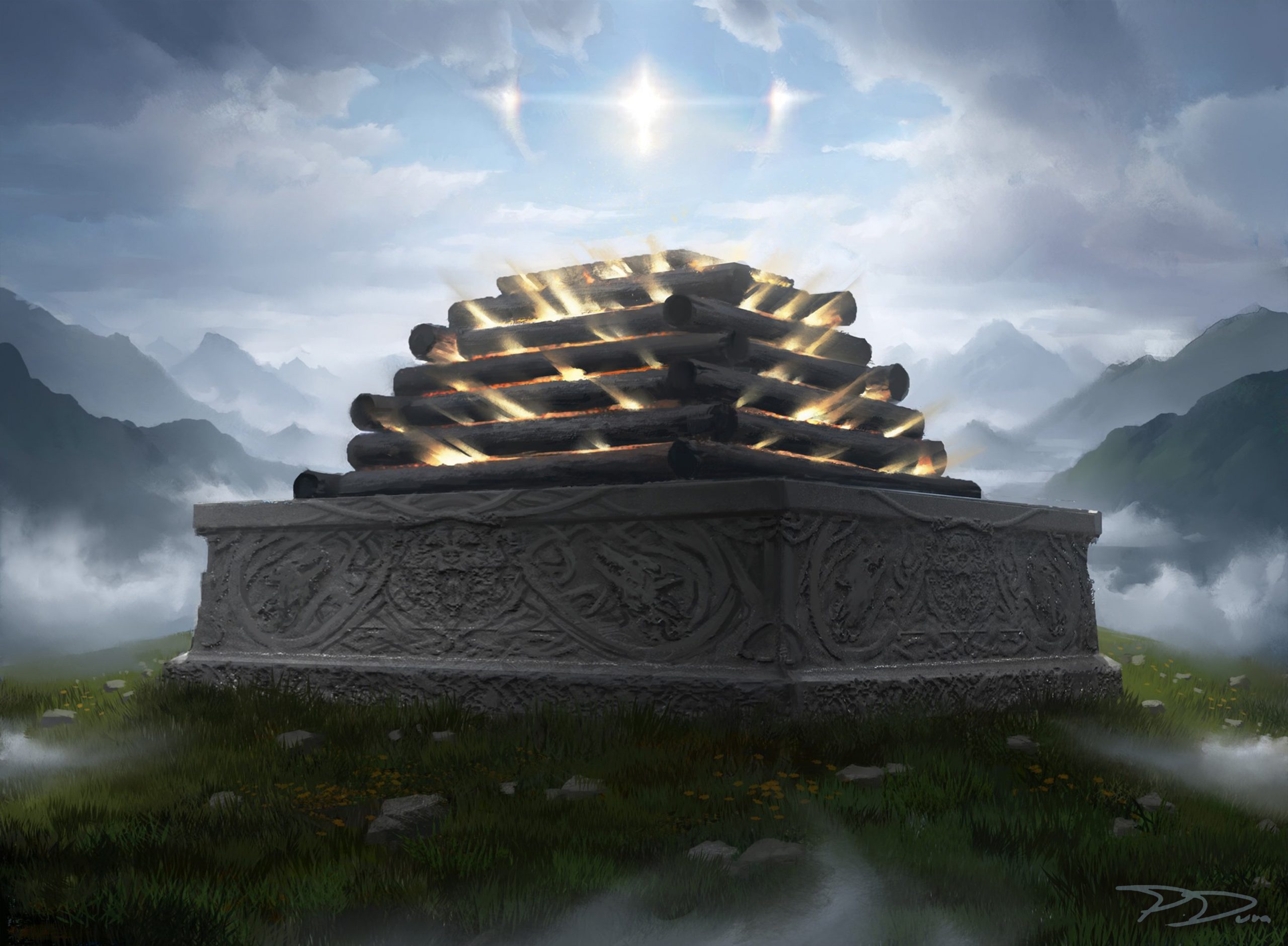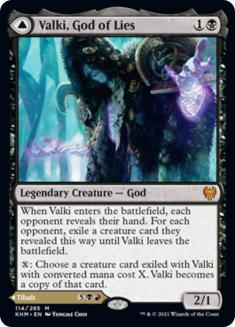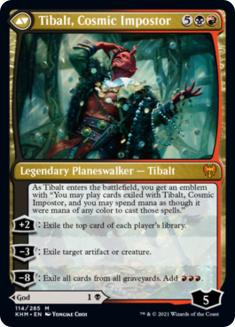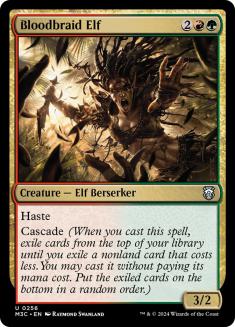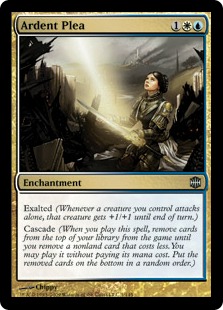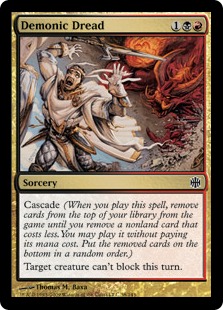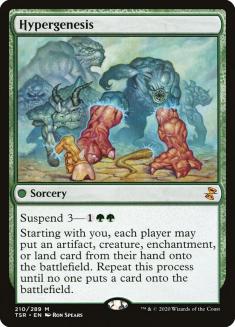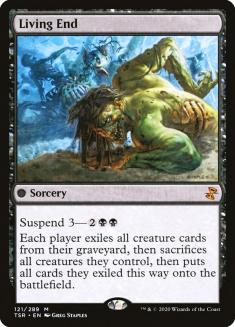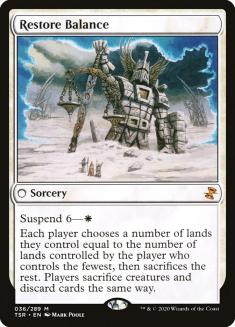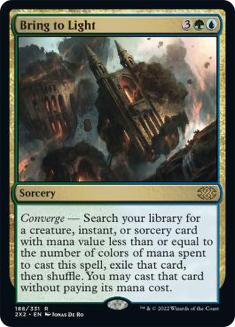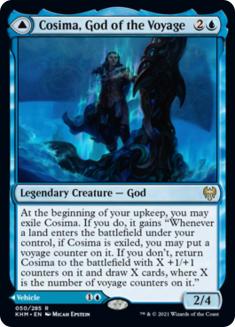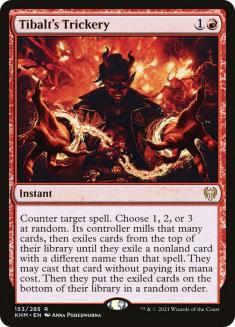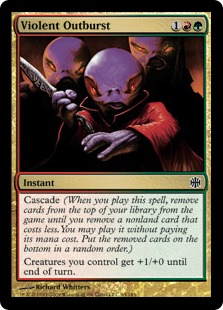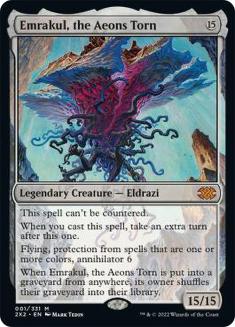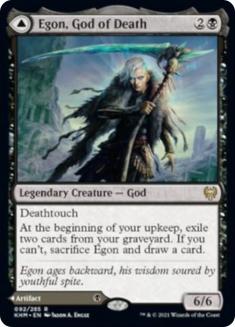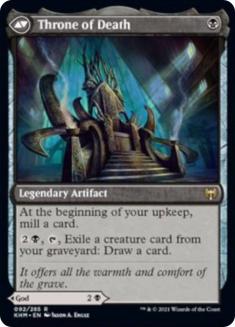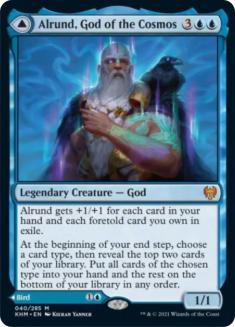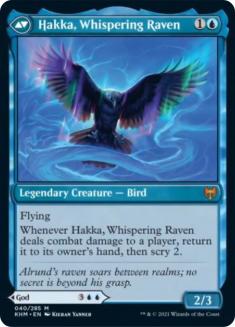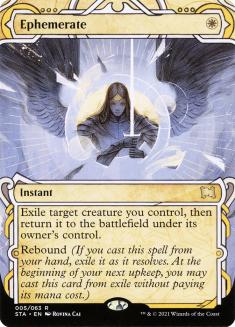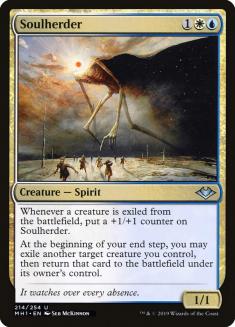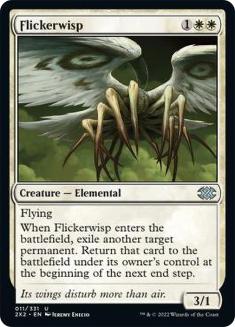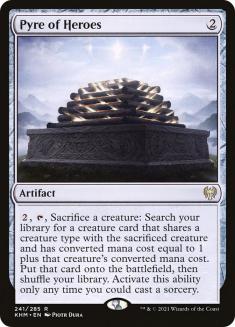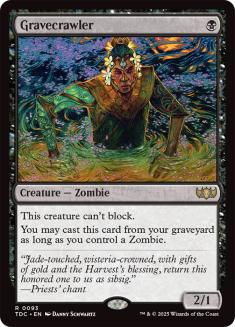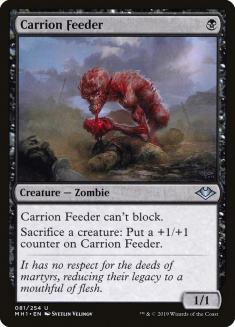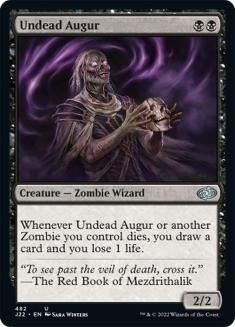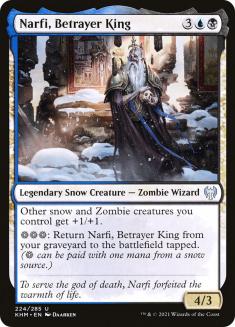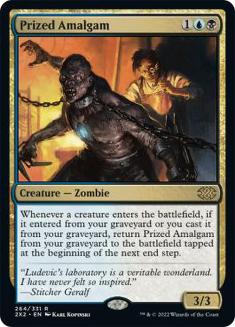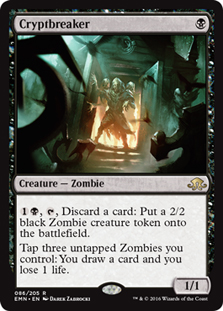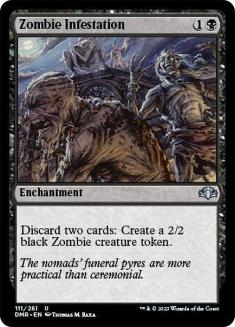Kaldheim is a welcome breath of fresh, wintry air for Standard. For Modern, its impact is less clear. The set’s most obviously good cards aren’t there on rate and its mechanics aren’t tempting by themselves or in the broad scope of Modern — the format won’t look like the inside of Arcum’s Astrolabe again anytime soon.
Appearances can be deceiving. Beneath the surface, quite a few cards have potential — you just have to haggle over the price.
1. Valki, God of Lies // Tibalt, Cosmic Impostor
Valki, God of Lies is at its most disruptive in Modern, oddly. Messing up the mana curve of Gruul Adventures or Mono-Green Food can slow their progress, but no Standard deck is so reliant on any one creature that this is more than a speed bump.
By contrast, many Modern decks base their entire gameplans on resolving and protecting specific creatures, making Valki a contextually powerful riff on Mesmeric Fiend or Tidehollow Sculler. The ability to copy the creature is less threatening as its targets become more specialized — you really have to mean it to want a Puresteel Paladin or Heliod, Sun-Crowned — but this is more a useful bonus than anything else. The dream of building your own Uro, Titan of Nature’s Wrath is alluring but hard to justify chasing.
Ultimately, two mana for a conditional discard spell is a lot more than one, and one toughness is a lot less than two in a format where Lava Dart and Wrenn and Six reign supreme. Valki doesn’t make it as a two-drop; Tibalt, Cosmic Impostor certainly doesn’t make it as a seven-drop. Why is it the headliner here?
The cascade mechanic has no shortage of wacky exploits, but the modal DFCs are happy to add to them. As long as the front side meets the converted mana cost restriction, you can cast either side for free. Valki is cheap enough to be eligible for any cascade card in Modern; Tibalt is expensive and flashy enough to be a worthy payoff.
Jund is a seemingly obvious home for this interaction. It’s in the market for new two-drops as Dark Confidant ages increasing poorly, Thoughtseize and Inquisition of Kozilek can protect Valki itself or team up with it to snag pairs of relevant cards, and Bloodbraid Elf is already present as the four-drop of choice.
The issue here is that one of the biggest weak links and locked-in cards in Modern Jund is, well, Bloodbraid Elf. As Modern decks become more powerful and streamlined, a four-drop needs to have a reliable, immediate impact. Bloodbraid Elf exacerbates the classic midrange issue of drawing the wrong cards for the matchup and even the ‘right’ cards often require a narrow window that a quasi-random four-drop can’t guarantee. If you don’t think Valki is good enough on its own merits, playing it to increase Bloodbraid Elf’s variance even more is a poor plan.
A more promising example is the family of cascade combo decks. Hypergenesis was dangerous enough in Extended that it earned a life sentence in Modern; Living End and Restore Balance saw occasional play in simpler times. Each of these effects is more powerful by some metrics than Tibalt, Cosmic Impostor but with much steeper deckbuilding requirements — if your deck contains twenty cycling creatures for Living End there’s not much room for anything else. Tibalt only asks that you cast it, freeing up room for other win conditions or ‘cheap’ interaction in the Modern card pool that pretends to be older or taller than it really is.
Creatures (18)
- 4 Simian Spirit Guide
- 2 Magus of the Moon
- 4 Seasoned Pyromancer
- 4 Bonecrusher Giant
- 4 Valki, God of Lies
Lands (20)
Spells (22)
Sideboard

Tibalt, Cosmic Impostor is unrivalled as a three-mana finisher and backing it up with high-quality interaction and threats like Bonecrusher Giant should reliably win a ‘fair’ game of Magic. In addition to eight ways to cast its namesake on the cheap, Jund Tibalt also features maindeck Blood Moon and sideboard hits like Leyline of the Void and Damping Matrix that can win the game by themselves against strategies fighting on a different axis. Seasoned Pyromancer and Valakut Awakening reward playing cards with such a polarized impact by making it much easier to dig for them when they matter or cash them in when they don’t. Valki itself is one such card but also offers an ideal Demonic Dread target against the creature-light decks where Valki’s own text is unlikely to matter.
This strategy isn’t tied to the Jund colours — a more ambitious nonblack manabase supporting Ardent Plea and enough blue cards such as Brazen Borrower to justify Force of Negation also sounds appealing.
Creatures (5)
Planeswalkers (3)
Lands (25)
Spells (27)

Creatures (9)
Planeswalkers (6)
Lands (32)
Spells (33)

The wording of Bring to Light also promises Tibalt at low, low prices. As with any toolbox effect, a new card can significantly increase its power and versatility at the cost of just one slot — neither of these lists is a ‘Tibalt deck,’ but one copy of Tibalt makes it much easier to be a Bring to Light deck.
Bring to Light was always a lot of things but until now it couldn’t be a resilient threat that you could race towards as soon as possible; Scapeshift could end the game, but only later and under certain conditions. As seen in the larger list, Omnath, Locus of Creation could fill that role — and Bring to Light was the perfect use for its mana generation — but Omnath carries its own weakness to removal. Crucially, you only need to cast Bring to Light with green and blue mana to uncover Valki-as-Tibalt, making it a realistic plan for beating Blood Moon beyond wasting your Bring to Light to answer it directly. And, once Tibalt arrives, any cards it exiles can be cast with as many Mountains as you like.
Kaldheim‘s wordiest God is begging to be played in a fetchland format and the Growth Spiral control decks are a natural home. Control mirrors in particular often involve establishing Field of the Dead supremacy — if you expect to make that many land drops in a game, Cosima looks like the best bargain of all.
2. Tibalt’s Trickery
Tibalt’s mischief in Modern is just beginning:
Creatures (3)
Lands (49)
Spells (8)

If you thought building around Tibalt was a tough challenge, Tibalt’s Trickery is the secret level that only opens up once you’ve slain that final boss. Violent Outburst cascades into Tibalt’s Trickery, which is guaranteed to turn that Outburst into Emrakul, the Aeons Torn as long as you have no spells with other names in your deck. The restrictions breeding this creativity are the strictest you’ll find — no ways of cheating converted mana costs, no trying to find redundant backups for your combo pieces, no agonizing over sideboard slots.
This replaces the usual deckbuilding decisions with strange toy problems — are you meant to play Zoetic Cavern so that, if you’re unlucky enough to draw Tibalt’s Trickery, you have a ‘spell’ you can hope to reroll into an Emrakul? If so, are you meant to run an otherwise useless fourth Emrakul just to maximize your odds in that unlikely scenario? Are scry lands like Zhalfirin Void even worth it when you’re priced into sending back any hand that doesn’t already have Violent Outburst?
3. Egon, God of Death // Throne of Death
These questions may not be that interesting, or ultimately relevant, but this deck joins the rogues’ gallery of decks whose mere existence gives Modern much of its charm. I have higher competitive hopes for another of Kaldheim‘s deities:
Graveyard decks from classic Dredge to Hogaak have flirted with creatures like Rotting Regisaur as pivots against graveyard hate in sideboard games. Egon, God of Death seems poorly suited to this role, as most of that graveyard hate limits its lifespan. On the other side, Throne of Death competes with quicker, dedicated graveyard enablers — even in the narrow class of artifacts that mill yourself, Codex Shredder and Shriekhorn mostly do that job better. Egon’s flexibility only goes so far when it’s less than the sum of its parts.
Thankfully, there’s a promising fringe archetype uniquely suited to using every part of the card:
Creatures (13)
Lands (19)
Spells (28)

The combination of Underworld Breach and Grinding Station has struggled to gain traction since the bannings of Mox Opal and Arcum’s Astrolabe. Each shell I’ve tried has suffered from problems that are hard to solve individually and impossible to solve at the same time given the lack of space — there are too few artifacts to set up Emry, Lurker of the Loch or Grinding Station; too few enablers for Mox Amber; too few ways to fill the graveyard; and no good backup plans to lessen your reliance on Underworld Breach.
However imperfectly, Egon somehow addresses all of those problems at once as well as being a juicy Unearth target to stabilize the battlefield (with Grinding Station sacrificing Throne of Death to set up that line if need be). If the game goes long, Throne of Death becomes a card draw engine that can find the all-important Underworld Breach.
Creatures (15)
Lands (16)
Spells (29)

A highly experimental deck that also seemed dead on arrival without Mox Opal, this shell shares the desire for both sides of Egon. Goryo’s Vengeance for Griselbrand has always been one of the most powerful sequences in Modern but has lacked the right supporting cast — this deck can play a strong fair game with Urza, Lord High Artificer and Emry, Lurker of the Loch with both adding other ‘modes’ to Goryo’s Vengeance. Mystic Sanctuary for Goryo’s Vengeance is an underexplored interaction in Modern in search of the right home.
4. Alrund, God of the Cosmos // Hakka, Whispering Raven
The power of blink effects with the modal DFCs is well-documented and Kaldheim gives many reasons to revisit that space. In Standard, this means Yorion, Sky Nomad (as all things do eventually). In Modern, we can aim much higher.
Creatures (27)
- 3 Venser, Shaper Savant
- 2 Flickerwisp
- 4 Wall of Omens
- 2 Watcher for Tomorrow
- 4 Soulherder
- 4 Skyclave Apparition
- 4 Glasspool Mimic
- 4 Alrund, God of the Cosmos
Lands (21)
Spells (12)
Sideboard

The more common Bant Blink decks excel at generating card advantage but struggle to stop spinning their tires and end the game if they’re under pressure. The plethora of cheap blink effects in Modern can turn Hakka, Whispering Raven into Alrund, God of the Cosmos as early as Turn 3, a much more consequential play than making Wall of Omens dance around. This deck’s high creature count, bolstered by another DFC in Glasspool Mimic, ensures that each Alrund trigger is likely to yield at least one card.
5. Pyre of Heroes
Pyre of Heroes is an enthusiastic young idealist who claims to admire Birthing Pod but lacks the radicalism that made Birthing Pod a danger to polite society. Pod was powerful enough to earn a permanent break from Modern in 2015 and every pushed creature printed since then would be a new tool in its arsenal — in another world, we could be turning Uro, Titan of Nature’s Wrath into Omnath, Locus of Creation! Pyre of Heroes is so restrictive that its power doesn’t scale in this way, even when the new set focuses on creature types with a strong pedigree.
The ability to move indirectly between different creature types makes it easy to miss Pyre’s full potential — you can turn a two-drop Human Warrior into a three-drop Cat Warrior and then a four-drop Cat Wizard, but you can’t skip a step in between. That said, it makes sense for any sketch of a Pyre deck to anchor itself in one creature type.
The obvious choice is Humans. Their status as the ‘default’ creature type for many years gives a wide range of options to chain together. What’s the point, though? If I cast a one-drop Human and then Pyre of Heroes, I can spend Turn 3 searching up a two-drop Human that’s probably highly vulnerable to removal. If that one-drop is a mana creature like Noble Hierarch, I can cast and activate Pyre to upgrade a two-drop to a three-drop, but it’s unclear that this is better than the less demanding creature toolbox cards in Modern.
The Zombie Pod decks from Dark Ascension Standard may prove to be a better template:
Creatures (30)
- 1 Withered Wretch
- 4 Carrion Feeder
- 1 Crypt Champion
- 4 Tidehollow Sculler
- 4 Gravecrawler
- 4 Geralf's Messenger
- 1 Diregraf Captain
- 1 Risen Executioner
- 1 Relentless Dead
- 4 Cryptbreaker
- 4 Undead Augur
- 1 Masked Vandal
Lands (22)
Spells (8)

Recursive creatures help the sacrificial payment for Pyre of Heroes and Zombies have a keen interest in sacrificing each other already. With enough time, Gravecrawler lets Pyre of Heroes churn out a two-drop every turn and finding tribal payoffs that care about Zombies dying makes this look like a reward rather than a cost.
Pyre of Heroes can also help unlikely connections within obscure tribes to flourish:
Creatures (31)
- 4 Trinket Mage
- 4 Grand Architect
- 4 Vedalken Certarch
- 1 Spellskite
- 4 Chief Engineer
- 4 Renowned Weaponsmith
- 4 Walking Ballista
- 1 Deputy of Detention
- 4 Urza, Lord High Artificer
- 1 Universal Automaton
Lands (4)
Spells (25)

There aren’t many Artificers to choose from but there are some useful links in their family tree — Renowned Weaponsmith, as a Human Artificer, can go through either Trinket Mage or Grand Architect to end up at Urza, Lord High Artificer. This deck can assemble a scary battlefield quickly while building a fast Walking Ballista to contain the opponent’s battlefield and using Trinket Mage to find the right tools to shut down linear strategies.
6. Narfi, Betrayer King
If you thought we were done with Zombies, you missed the return of the King:
Creatures (28)
- 4 Carrion Feeder
- 4 Hedron Crab
- 4 Vengevine
- 4 Gravecrawler
- 4 Prized Amalgam
- 4 Cryptbreaker
- 4 Stitcher's Supplier
Lands (22)
Spells (10)

The graveyards of Modern are full of creatures that can return themselves but most require you to jump through a series of hoops or are unimpressive on their own. Narfi, Betrayer King is unique in having a game-changing effect while only asking you to invest mana. A Narfi activation with some material on the battlefield and a Prized Amalgam in the graveyard represents double digits in additional power for just three mana — and, if this is answered somehow, you can just repeat it every turn until it sticks.
This does require snow mana, forcing careful manabase construction and preventing the common green splash that makes Vengevine castable and opens up cards like Nature’s Claim or Assassin’s Trophy to answer graveyard hate. Ice Tunnel isn’t a Modern-quality land but it’s a small price to pay to unlock Narfi.
If we can’t answer graveyard hate, we have to play through it. Cryptbreaker and Zombie Infestation aid your primary plan by binning graveyard payoffs and become the backup plan by converting those now-useless payoffs into other resources. Consider:
- Turn 1: Cryptbreaker
- Turn 2: Discard Narfi to create a 2/2 Zombie
- Turn 3: Return Narfi from the graveyard, attack for five
Or:
- Turn 2: Zombie Infestation; discard Narfi, Prized Amalgam, and two other cards to create two 2/2 Zombies
- Turn 3: Return Narfi, attack for six with fourteen total power on the battlefield
In addition, Prized Amalgam and Narfi are realistically castable in longer games, especially if the opponent is forced to ramp you with Path to Exile. Though this maindeck is light on interaction, Dimir Zombies❄ enjoys access to Thoughtseize and Fatal Push and even has enough blue cards to support Force of Negation.
Kaldheim‘s vibe shines through in its DFCs — innocuous on the surface but glistening with potential if you look at the right side.

